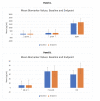Blueberry Supplementation Effects on Neuronal and Pathological Biomarkers in Subjects at Risk for Alzheimer's Disease: A Pilot Study
- PMID: 37637274
- PMCID: PMC10450204
- DOI: 10.14283/jarlife.2023.13
Blueberry Supplementation Effects on Neuronal and Pathological Biomarkers in Subjects at Risk for Alzheimer's Disease: A Pilot Study
Erratum in
-
Erratum to: Blueberry Supplementation Effects on Neuronal and Pathological Biomarkers in Subjects at Risk for Alzheimer's Disease: A Pilot Study.JAR Life. 2023 Sep 25;12:84. doi: 10.14283/jarlife.2023.14. eCollection 2023. JAR Life. 2023. PMID: 37808442 Free PMC article.
Abstract
Background: There is a need to develop non-invasive practical lifestyle interventions for preventing Alzheimer's disease (AD) in people at risk, such as those with mild cognitive impairment (MCI). Blueberry consumption has been associated with reduced risk of dementia in some epidemiologic studies and with improvements in cognition in healthy aging adults. Blood-based biomarkers have emerged at the forefront of AD therapeutics research spurred by the development of reliable ultra-sensitive "single-molecule array" assays with 100-1000-fold greater sensitivity over traditional platforms.
Objective: The purpose of this study was to examine the effect of blueberry supplementation in MCI on six blood biomarkers: amyloid-beta 40 (Aβ40), amyloid-beta 42 (Aβ42), phosphorylated Tau181 (ptau181), neurofilament light (NfL), Glial Fibrillary acidic protein (GFAP), and Brain-Derived Neurotrophic Factor (BDNF).
Methods: This was a 12-week, open-label, pilot trial of 10 participants with MCI (mean age 80.2 years + 5.16). Subjects consumed 36 grams per day of lyophilized blueberry powder in a split dose consumed with breakfast and dinner. Baseline and endpoint venous blood was analyzed using an ultrasensitive SIMOA assay. Our aim was to test if blueberry supplementation would particularly impact p-tau181, NfL, and GFAP elevations associated with the neurodegenerative process.
Results: There were no statistically significant (p < 0.05) changes from baseline to endpoint for any of the biomarker values or in the ratios of Aβ42 / Aβ40 and ptau181/ Aβ42. Adverse effects were mild and transient; supplementation was relatively well tolerated with all subjects completing the study.
Conclusion: To our knowledge, this is the first study to prospectively examine the effects of blueberry supplementation on a panel of blood biomarkers reflecting the neurodegenerative process. Our findings raise two possibilities - a potential stabilization of the neurodegenerative process or a lack of a direct and acute effect on beta-amyloid/tau/glial markers. A larger controlled study is warranted.
Keywords: Alzheimer’s; Dementia; anthocyanins; biomarkers; longevity; microglia; neurons.
© The Author(s) 2023.
Conflict of interest statement
PMD has received research grants from the National Institute on Aging, DARPA, DOD, ONR, Salix, Avanir, Avid, Cure Alzheimer’s Fund, Karen L. Wrenn Trust, Steve Aoki Foundation, US Highbush Blueberry Council and advisory fees from UMethod, Clearview, Lumos, Neuroglee, Otsuka, Lundbeck, Compass, Vitakey, Sermo, Lilly, Nutricia, and Transposon. PMD is a co-inventor of patents for the diagnosis or treatment of Alzheimer’s disease and a patent for infection detection. PMD owns shares in several biotechnology companies whose products are not discussed here. PMD serves on boards of healthsystems and advocacy groups. MGM has received research grants from the Durham Veterans Affairs Health Care System, the US Highbush Blueberry Council, the NIH via work for the Alzheimer’s Disease Research Center, and the Egg Nutrition Center. The remaining authors declare that the research was conducted in the absence of any commercial or financial relationships that could be construed as a potential conflict of interest.
Figures
Similar articles
-
Plasma Aβ42/40 ratio, p-tau181, GFAP, and NfL across the Alzheimer's disease continuum: A cross-sectional and longitudinal study in the AIBL cohort.Alzheimers Dement. 2023 Apr;19(4):1117-1134. doi: 10.1002/alz.12724. Epub 2022 Jul 21. Alzheimers Dement. 2023. PMID: 36574591
-
Plasma biomarkers for diagnosis of Alzheimer's disease and prediction of cognitive decline in individuals with mild cognitive impairment.Front Neurol. 2023 Mar 2;14:1069411. doi: 10.3389/fneur.2023.1069411. eCollection 2023. Front Neurol. 2023. PMID: 36937522 Free PMC article.
-
Risk of Alzheimer's disease is associated with longitudinal changes in plasma biomarkers in the multi-ethnic Washington Heights-Hamilton Heights-Inwood Columbia Aging Project (WHICAP) cohort.Alzheimers Dement. 2024 Mar;20(3):1988-1999. doi: 10.1002/alz.13652. Epub 2024 Jan 6. Alzheimers Dement. 2024. PMID: 38183363 Free PMC article.
-
Predictive Accuracy of Blood-Derived Biomarkers for Amyloid-β Brain Deposition Along with the Alzheimer's Disease Continuum: A Systematic Review.J Alzheimers Dis. 2021;84(1):393-407. doi: 10.3233/JAD-210496. J Alzheimers Dis. 2021. PMID: 34542072
-
Blood biomarkers for vascular cognitive impairment based on neuronal function: a systematic review and meta-analysis.Front Neurol. 2025 Feb 7;16:1496711. doi: 10.3389/fneur.2025.1496711. eCollection 2025. Front Neurol. 2025. PMID: 39990267 Free PMC article. Review.
Cited by
-
Flavonoid-Rich Fruit Intake in Midlife and Late-Life and Associations with Risk of Dementia: The Framingham Heart Study.J Prev Alzheimers Dis. 2024;11(5):1270-1279. doi: 10.14283/jpad.2024.116. J Prev Alzheimers Dis. 2024. PMID: 39350372 Free PMC article.
References
-
- Alzheimer’s Association. 2023. Alzheimer’s Disase Facts and Figures. https://www.alz.org/media/documents/alzheimers-facts-and-figures.pdf
-
- Grundman M, Petersen RC, Ferris SH, Thomas RG, Aisen PS, Bennett DA, Foster NL, Jack J, Clifford R, Galasko DR, Doody R, Kaye J, Sano M, Mohs R, Gauthier S, Kim HT, Jin S, Schultz AN, Schafer K, Mulnard R (2004) Mild Cognitive Impairment Can be Distinguished from Alzheimer’s Disease and Normal Aging for Clinical Trials. Arch Neurol 61, 59-66. - PubMed
-
- Amano, T., Park, S., Morrow-Howell, N., & Carpenter, B. (2022). The association between patterns of social engagement and conversion from mild cognitive impairment to dementia: Evidence from the health and retirement study. Alzheimer Disease and Associated Disorders, 36(1), 7-14. - PubMed
-
- Baker, L. D., Frank, L. L., Foster-Schubert, K., Green, P. S., Wilkinson, C. W., McTiernan, A., Plymate, S. R., Fishel, M. A., Watson, G. S., Cholerton, B. A., Duncan, G. E., Mehta, P. D., & Craft, S. (2010). Effects of aerobic exercise on mild cognitive impairment: A controlled trial. Archives of Neurology (Chicago), 67(1), 71-79. - PMC - PubMed
LinkOut - more resources
Full Text Sources
Miscellaneous




